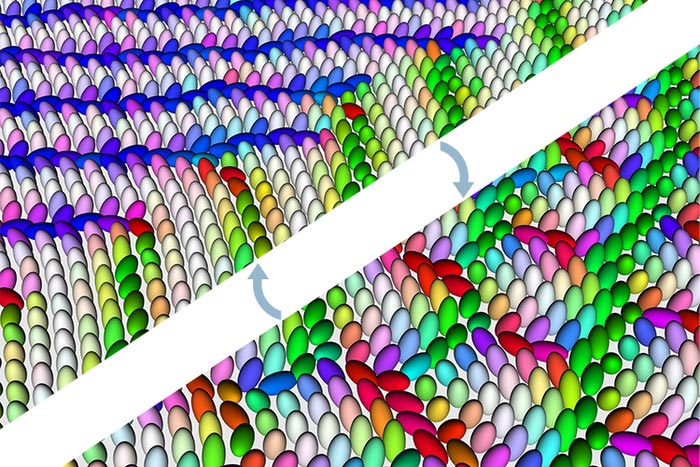Elastic fields stretch the understanding of chiral molecular crystals

A team led by a Institute of Industrial Science, The University of Tokyo researcher has created a model to probe the role of emergent elastic fields in chiral molecular crystals
Credit: Institute of Industrial Science, The University of Tokyo
Harnessing the properties of materials so that technology can continue to move forward means getting to grips with increasingly more challenging systems. A team led by a researcher from Institute of Industrial Science, The University of Tokyo has turned its focus to chiral molecular and colloidal crystals, revealing the role of emergent elastic fields in their behavior. Their findings are published in Proceedings of the National Academy of Sciences.
It is easy for most people to picture the properties of the basic phases of matter we learn about at school. However, the frontiers of technology often draw on areas where things are less clear cut. For example, liquid crystal phases combine the molecule mobility of liquids and ordering or solids and this has allowed them to be applied in displays for a huge range of consumer devices. The transitions within these more complex phases can also be challenging to visualize.
Topological phase transitions involve the rearrangement of the components of a material—whether they are molecules or particles—into helix or vortex-like structures, known as skyrmions. The role that topological phase transitions play in certain chiral materials, such as liquid crystals and metal-organic frameworks, has been explored previously. However, it has not been investigated for chiral molecular or colloidal crystals. Chirality is the property of handedness, a good example of which is that our hands appear the same, but in fact do not stack on top of each other—they are non-superimposable mirror images.
The researchers created a model that allowed them to assess the interaction between the intermolecular chiral twisting and spheroidal steric interactions in two-dimensional chiral molecular and colloidal crystals.
“Our model revealed that the competition between chiral twisting and steric anisotropy induced emergent elastic fields in the crystals,” explains study author Kyohei Takae. “This gives us the potential to control the phase transitions, providing us with a useful switch when developing applications.”
The researchers demonstrated that the elastic coupling of the phase could be controlled using external triggers such as changing the temperature or applying an electromagnetic field or anisotropic stress.
“Identifying the fundamental factors that underlie the behavior of materials is the first step in the development of new technologies,” says Dr. Kyohei Takae. “Our model has successfully demonstrated the importance of emergent elastic fields in chiral molecular crystals and is expected to make a significant contribution to future progress in electro- and magneto-mechanical devices.”
The study, “Emergent elastic fields induced by topological phase transitions: Impact of molecular chirality and steric anisotropy”, was published in Proceedings of the National Academy of Sciences at DOI: 10.1073/pnas.2118492119.
About Institute of Industrial Science (IIS), The University of Tokyo
Institute of Industrial Science (IIS), The University of Tokyo is one of the largest university-attached research institutes in Japan.
More than 120 research laboratories, each headed by a faculty member, comprise IIS, with more than 1,200 members including approximately 400 staff and 800 students actively engaged in education and research. Our activities cover almost all the areas of engineering disciplines. Since its foundation in 1949, IIS has worked to bridge the huge gaps that exist between academic disciplines and realworld applications.
Journal: Proceedings of the National Academy of Sciences
DOI: 10.1073/pnas.2118492119
Article Title: Emergent elastic fields induced by topological phase transitions: Impact of molecular chirality and steric anisotropy
Article Publication Date: 28-Mar-2022
Media Contact
Kyohei Takae
Institute of Industrial Science, The University of Tokyo
takae@iis.u-tokyo.ac.jp
Office: 81-3-5452-6125
Original Source
All latest news from the category: Physics and Astronomy
This area deals with the fundamental laws and building blocks of nature and how they interact, the properties and the behavior of matter, and research into space and time and their structures.
innovations-report provides in-depth reports and articles on subjects such as astrophysics, laser technologies, nuclear, quantum, particle and solid-state physics, nanotechnologies, planetary research and findings (Mars, Venus) and developments related to the Hubble Telescope.
Newest articles

Innovative 3D printed scaffolds offer new hope for bone healing
Researchers at the Institute for Bioengineering of Catalonia have developed novel 3D printed PLA-CaP scaffolds that promote blood vessel formation, ensuring better healing and regeneration of bone tissue. Bone is…

The surprising role of gut infection in Alzheimer’s disease
ASU- and Banner Alzheimer’s Institute-led study implicates link between a common virus and the disease, which travels from the gut to the brain and may be a target for antiviral…

Molecular gardening: New enzymes discovered for protein modification pruning
How deubiquitinases USP53 and USP54 cleave long polyubiquitin chains and how the former is linked to liver disease in children. Deubiquitinases (DUBs) are enzymes used by cells to trim protein…


